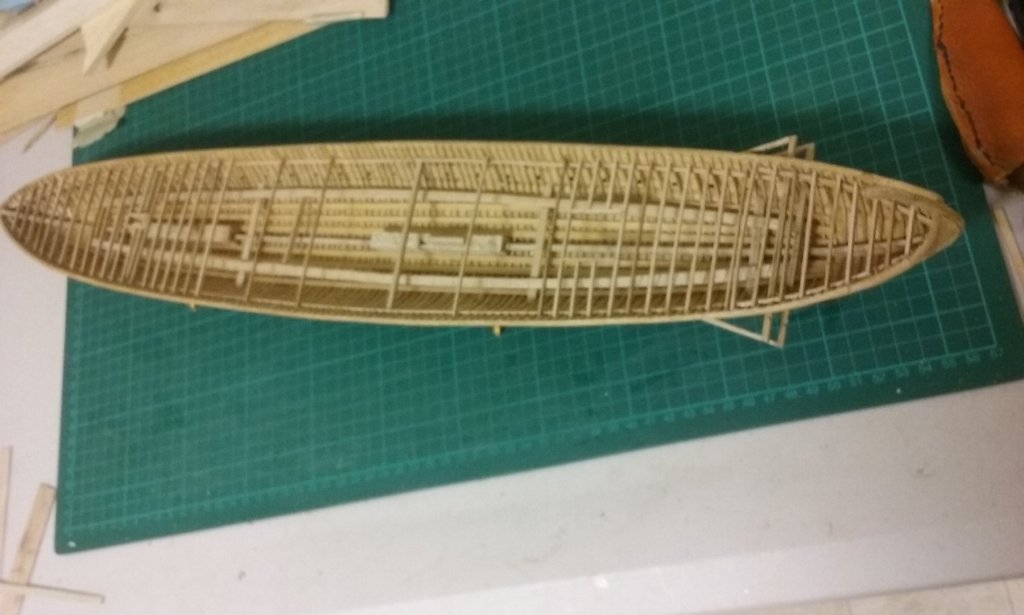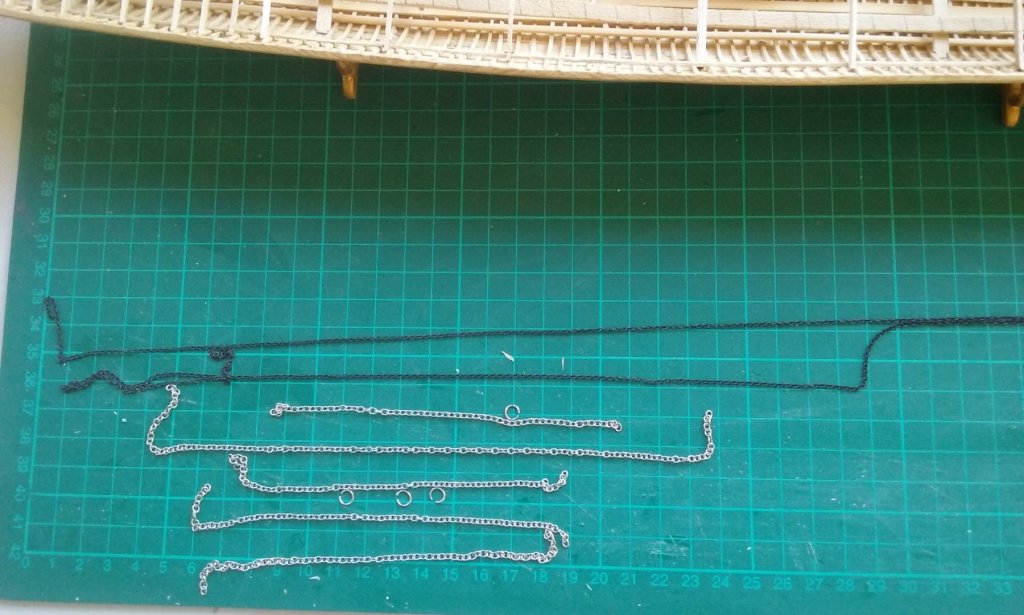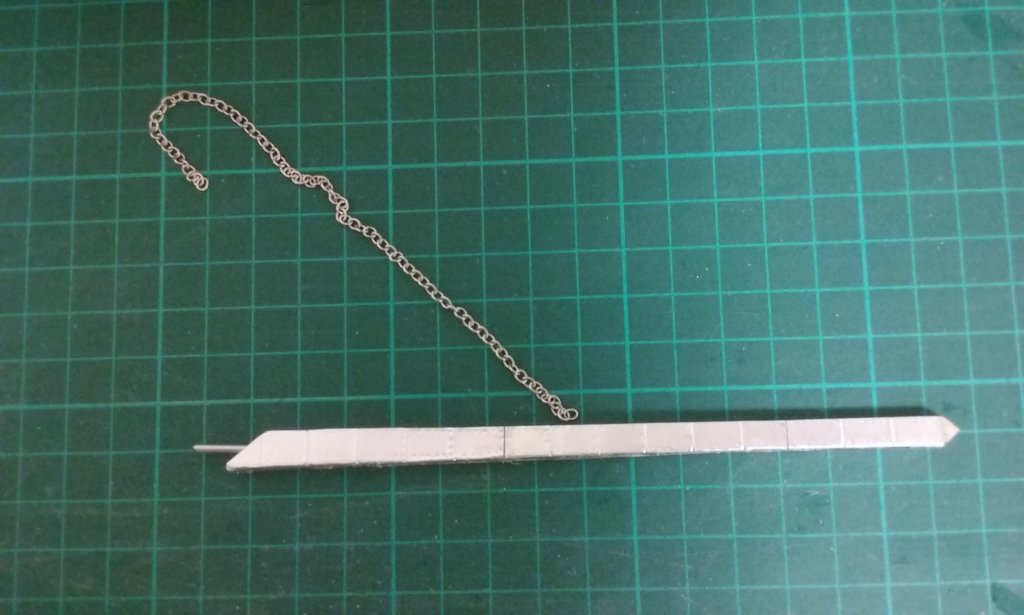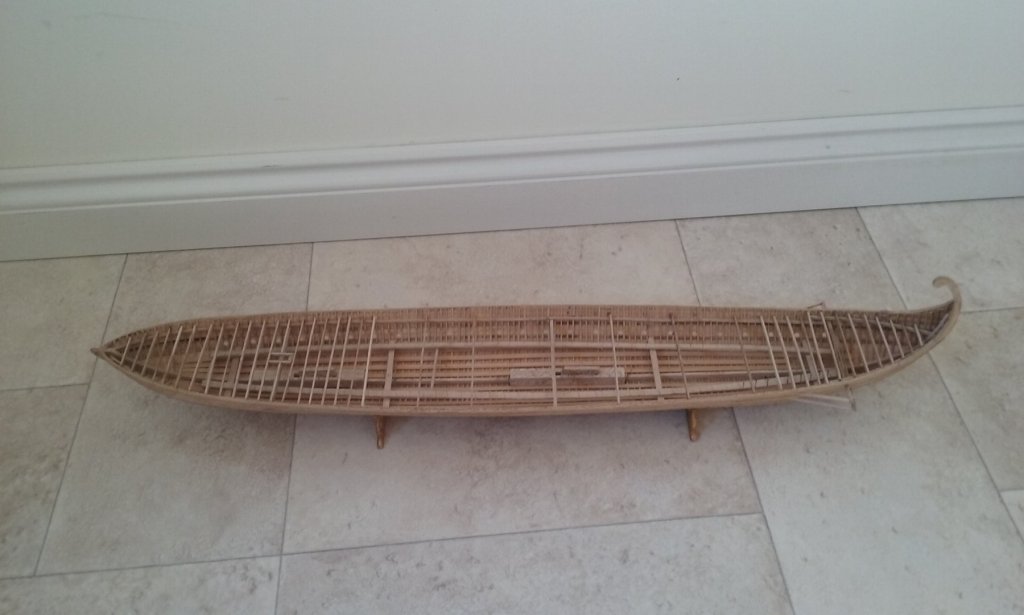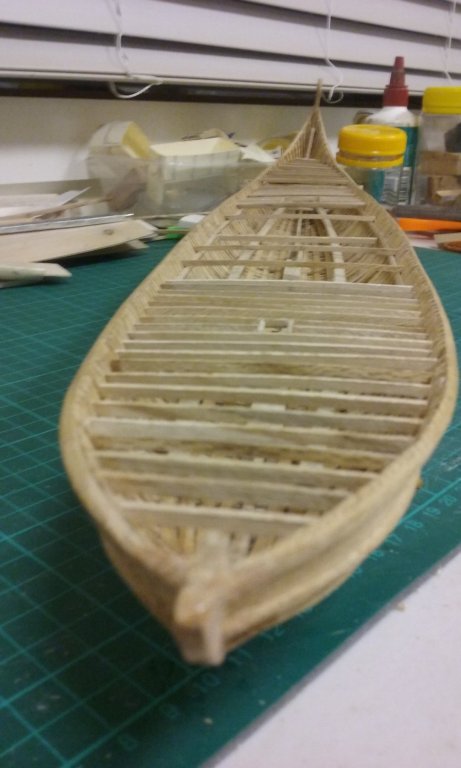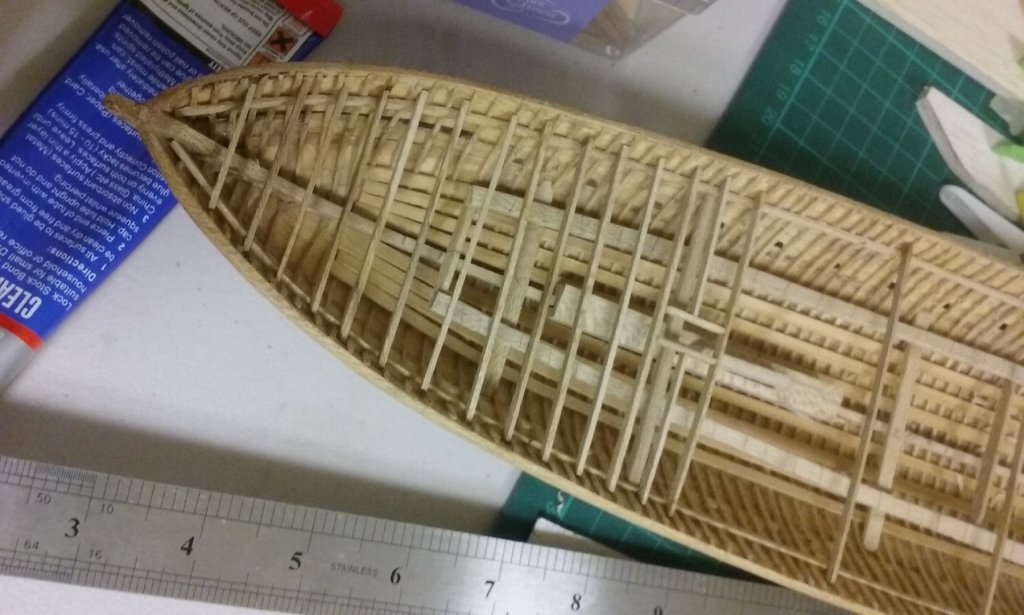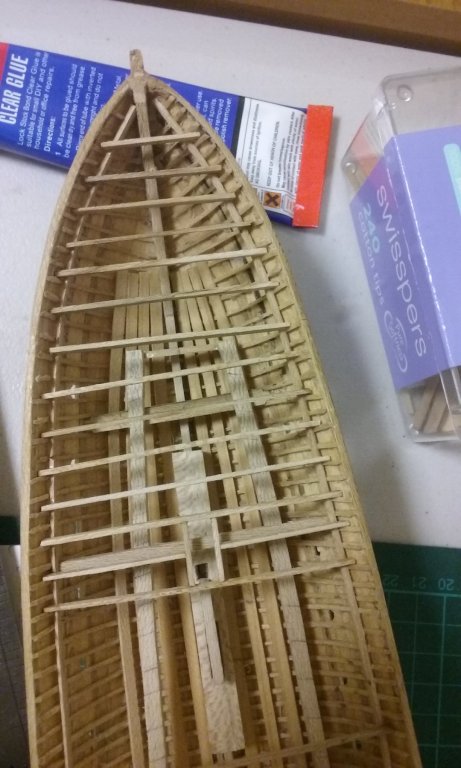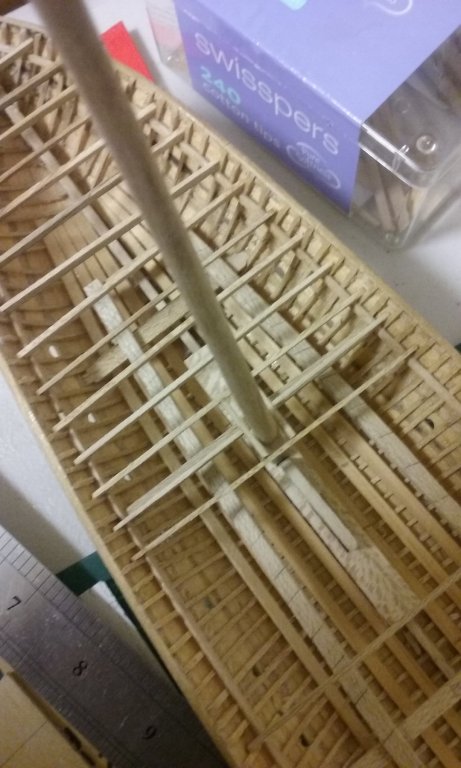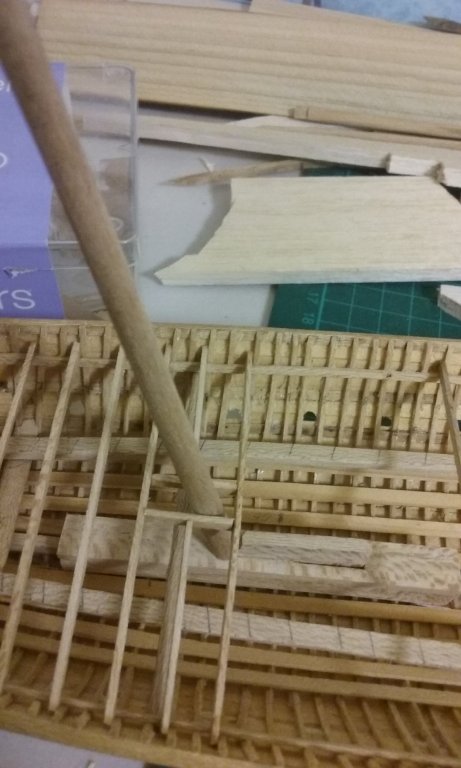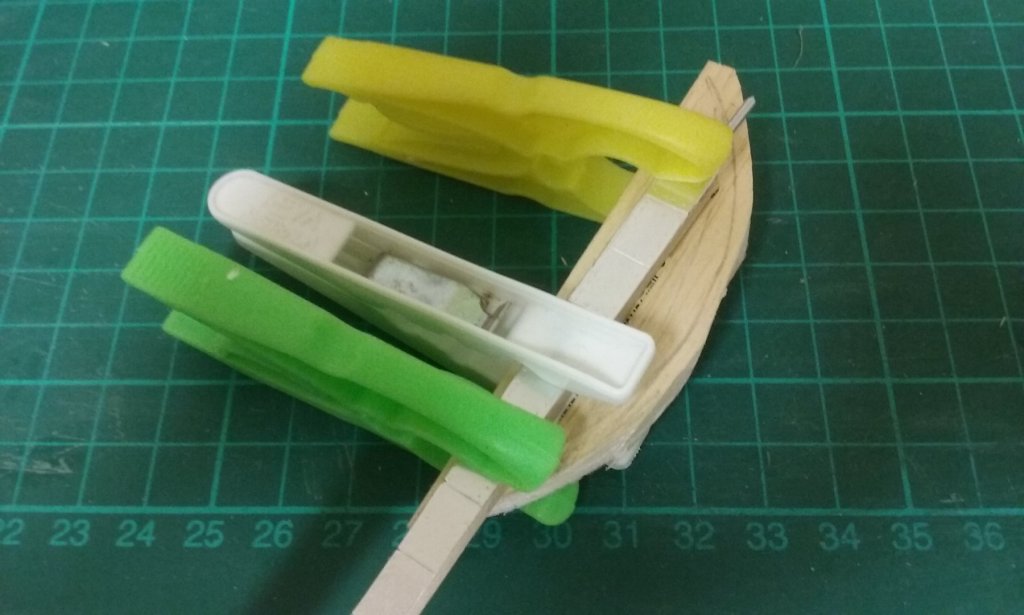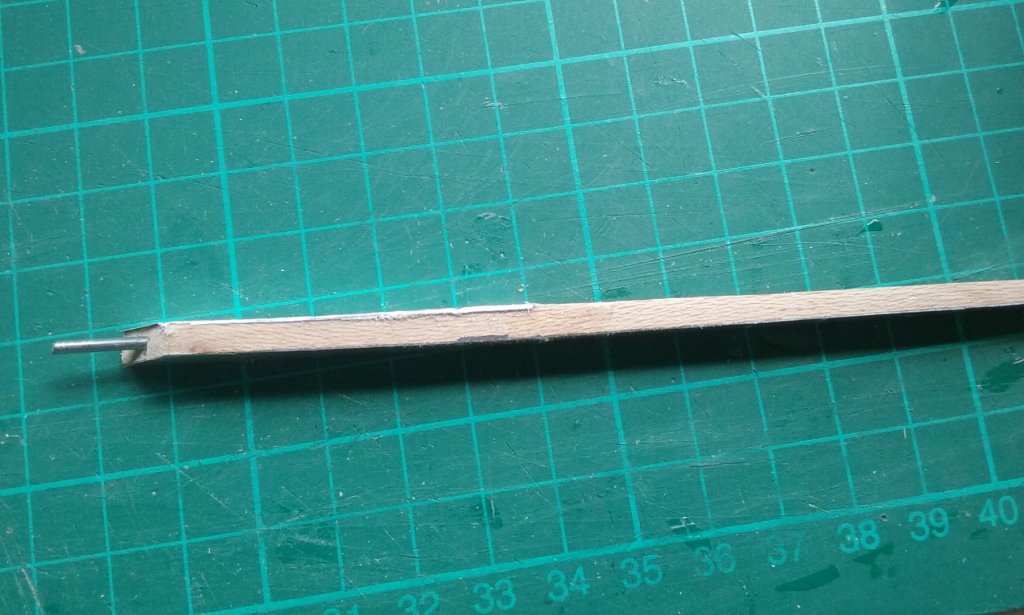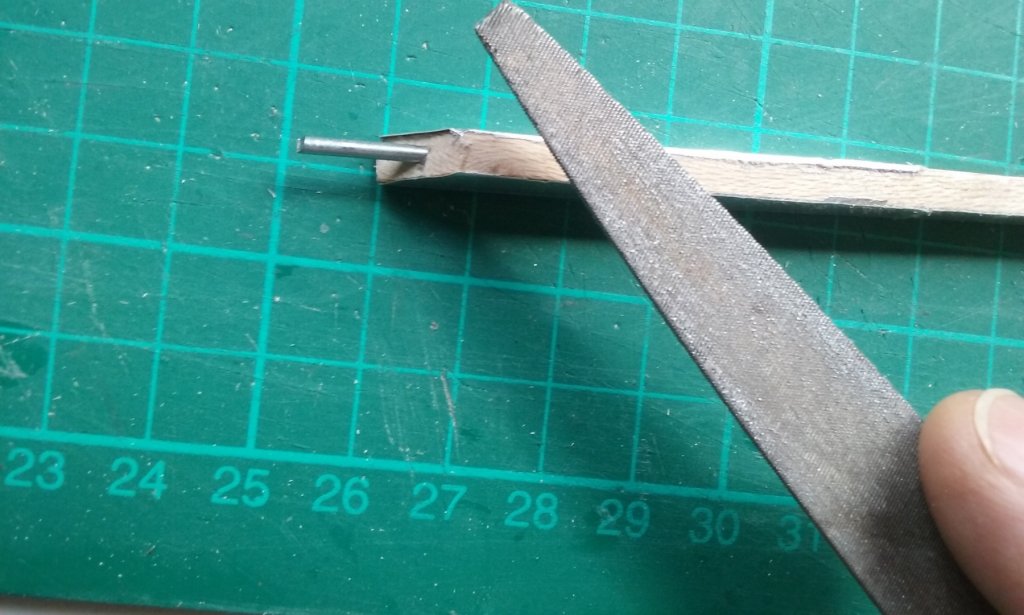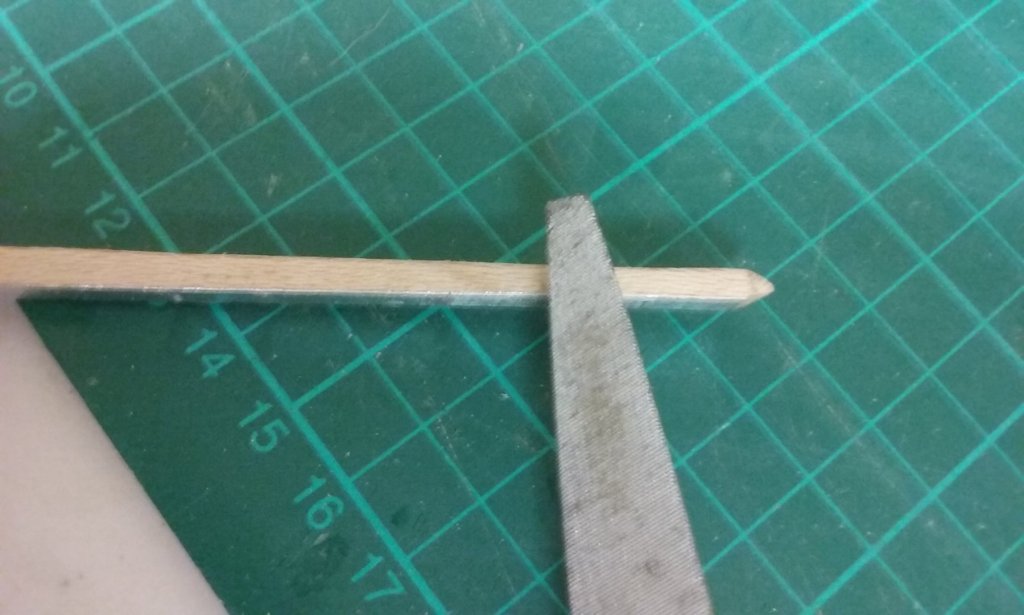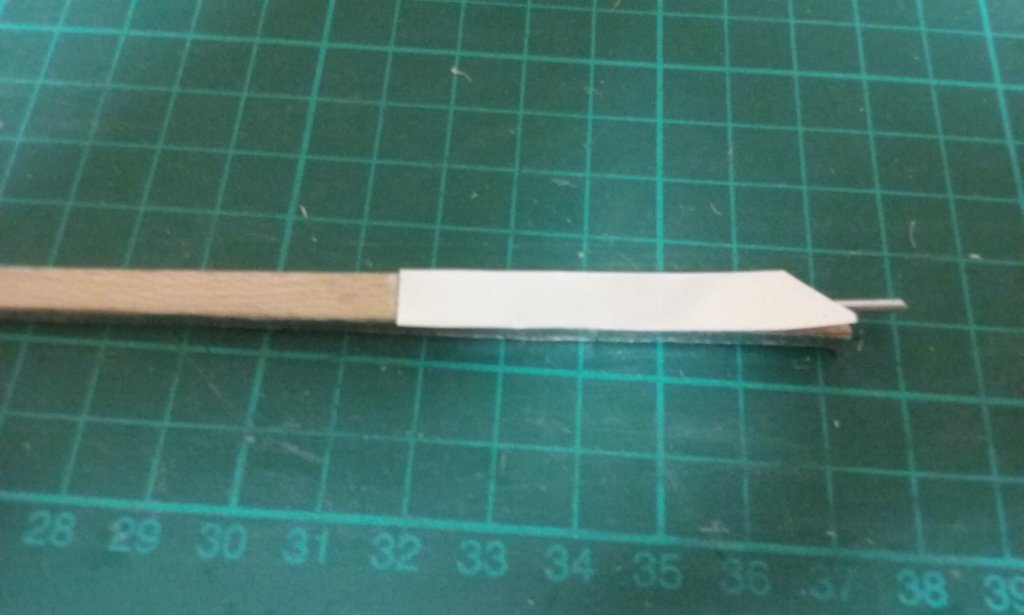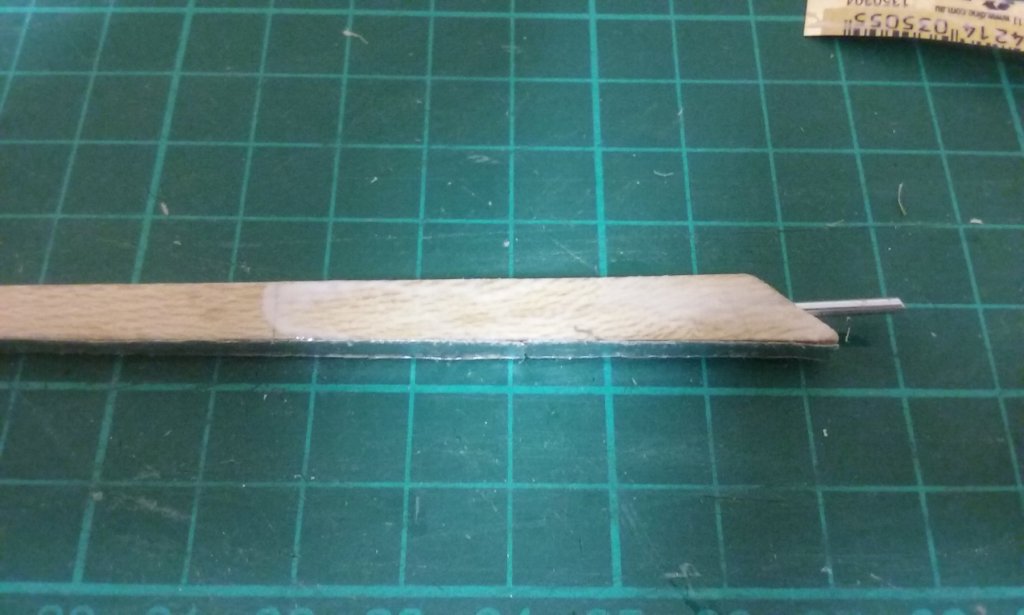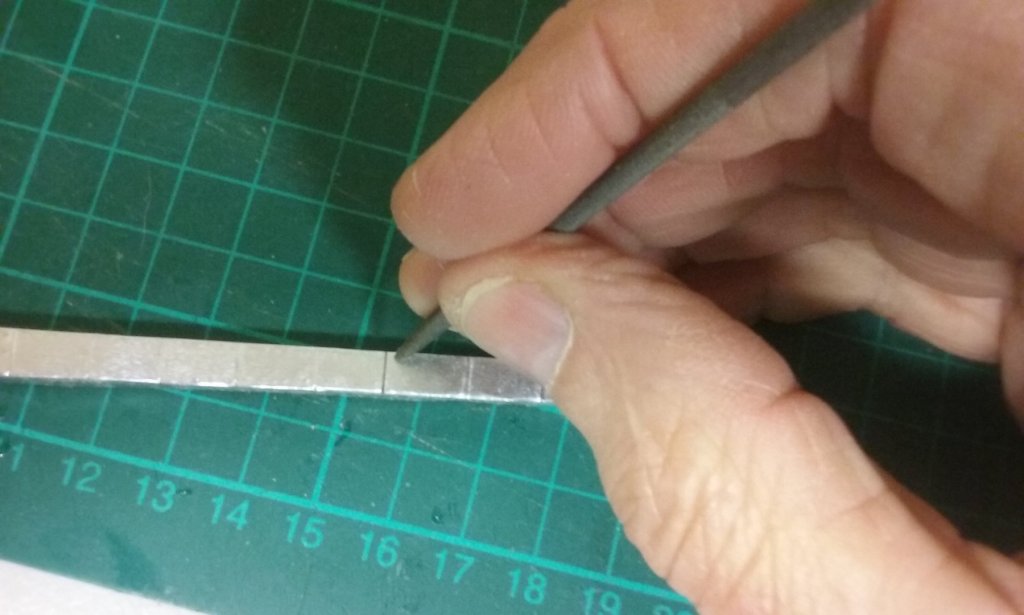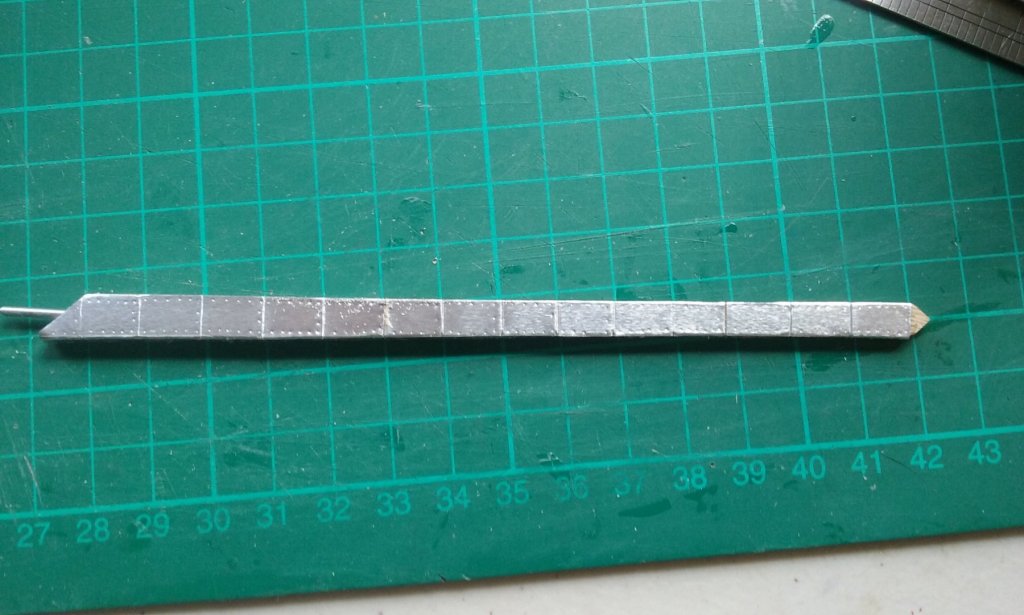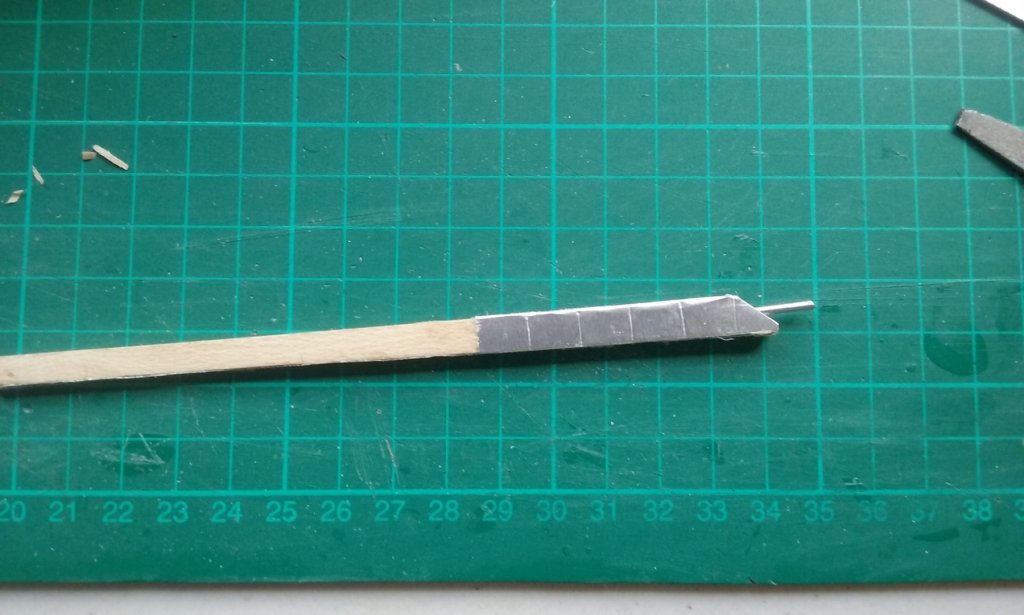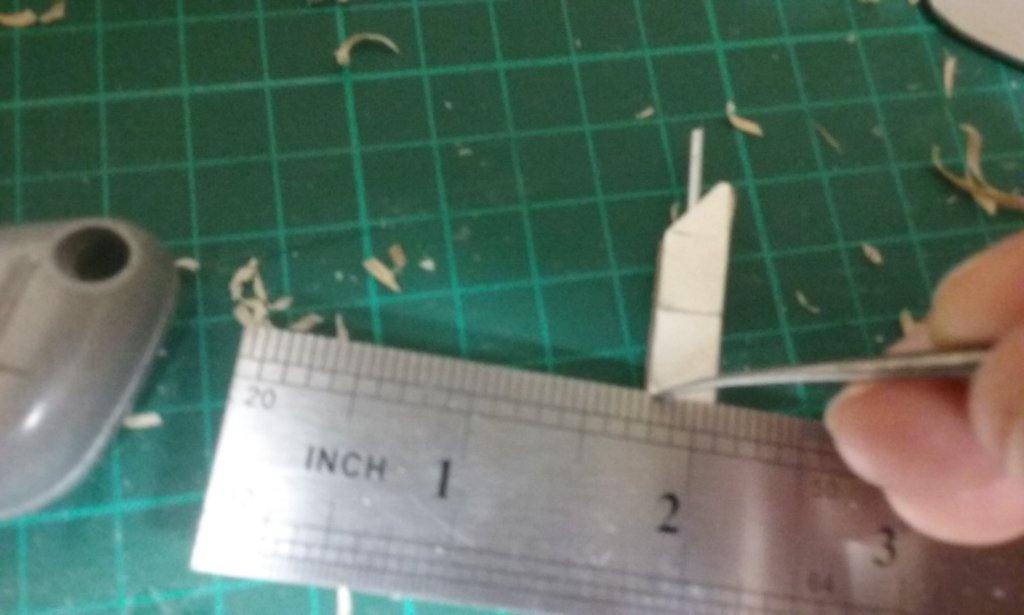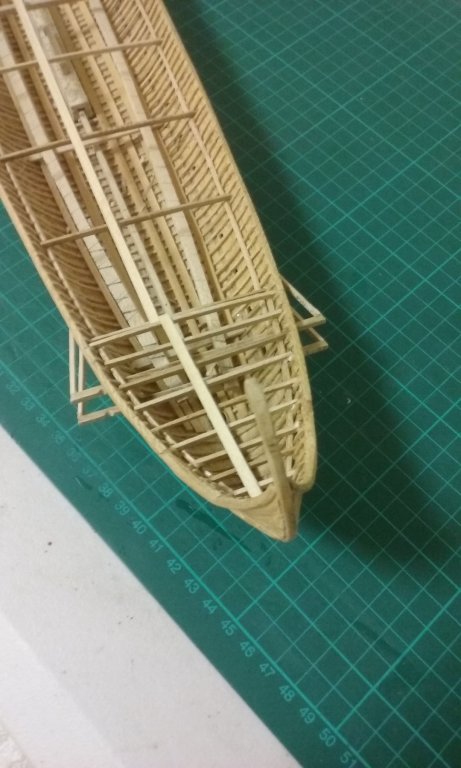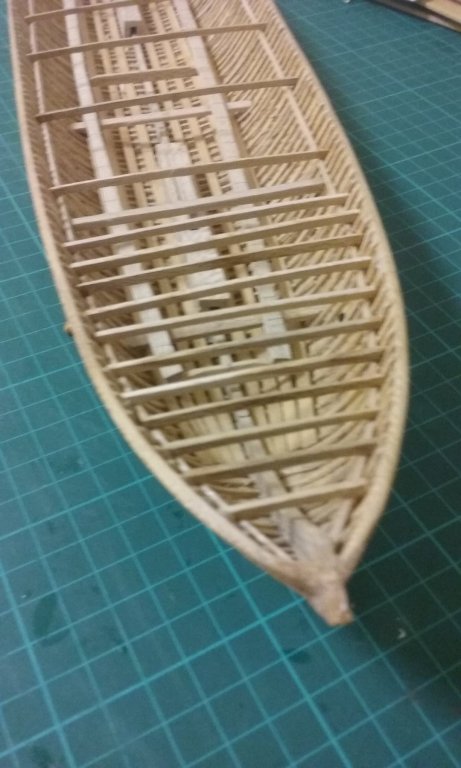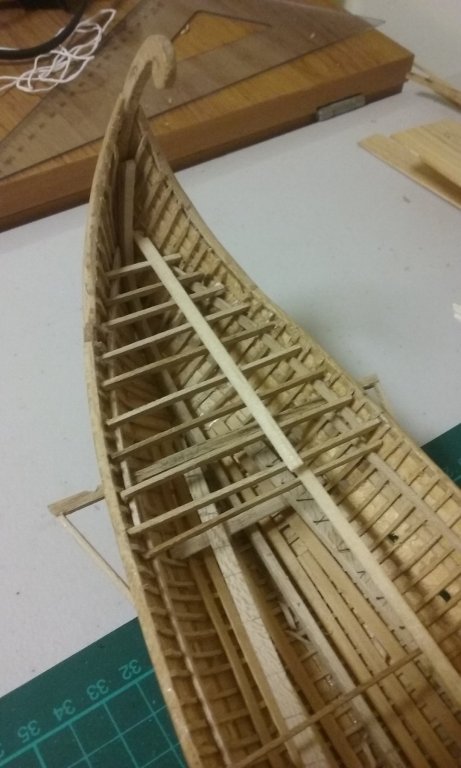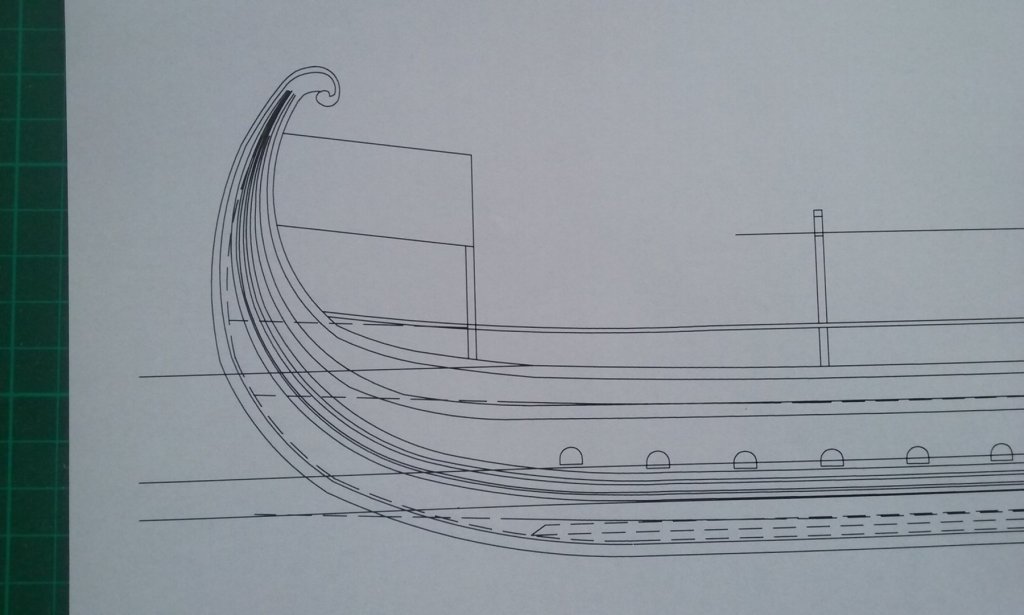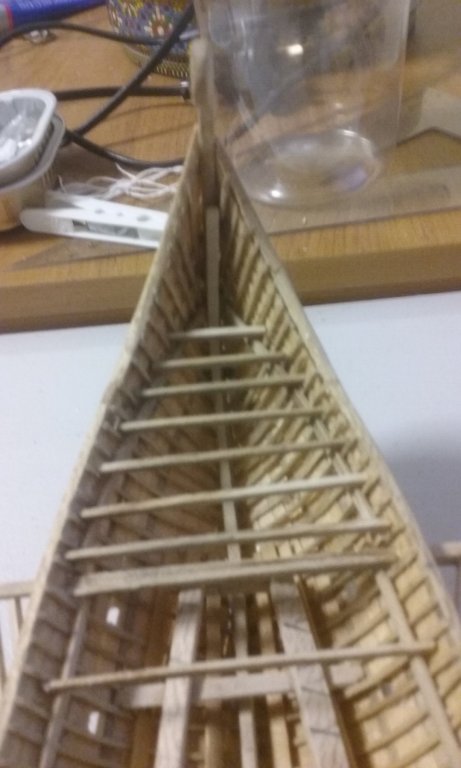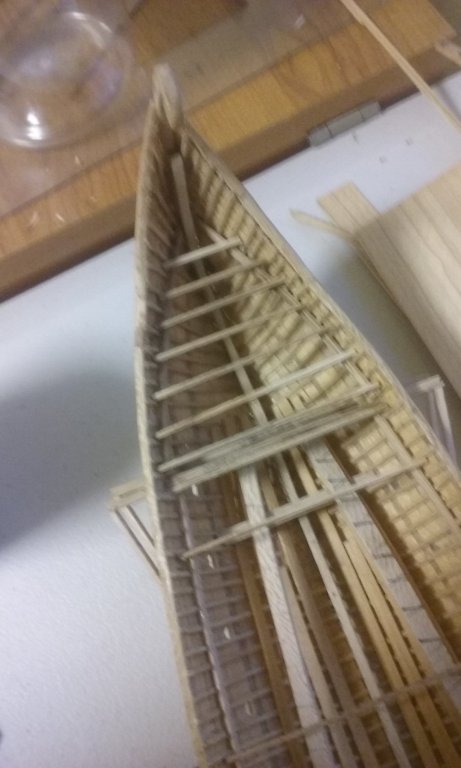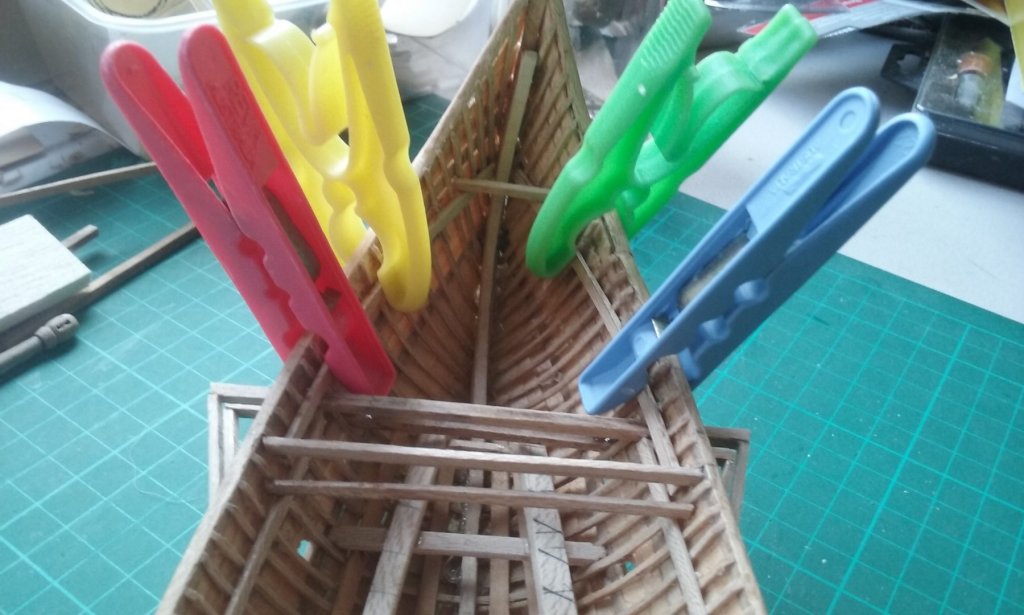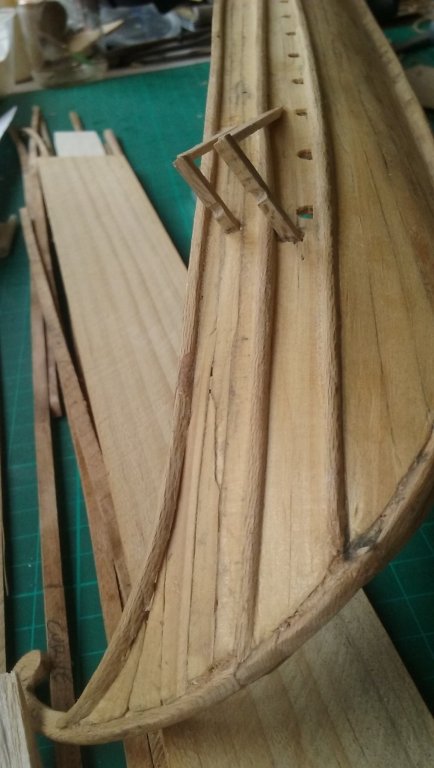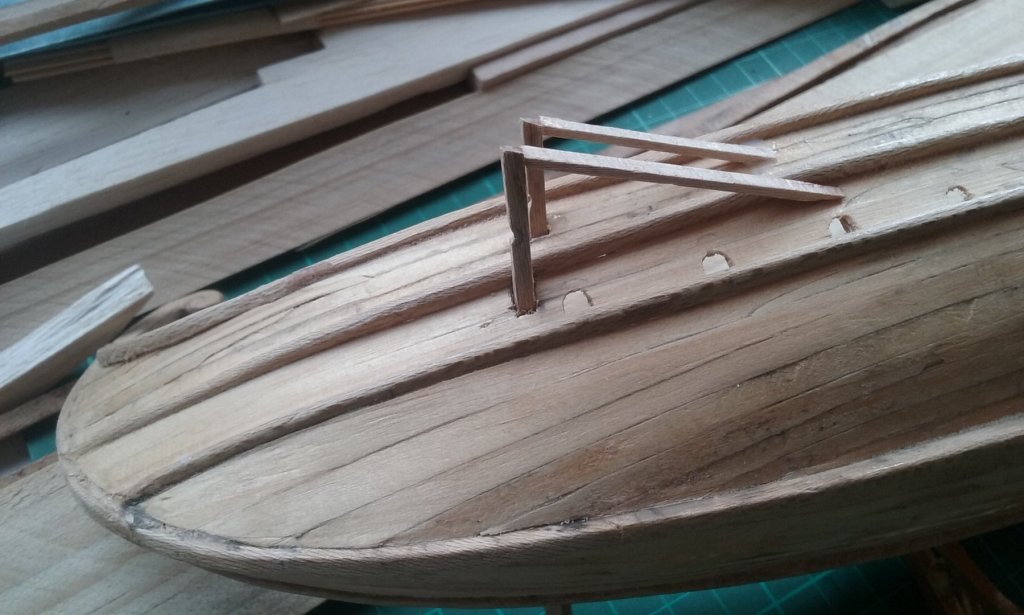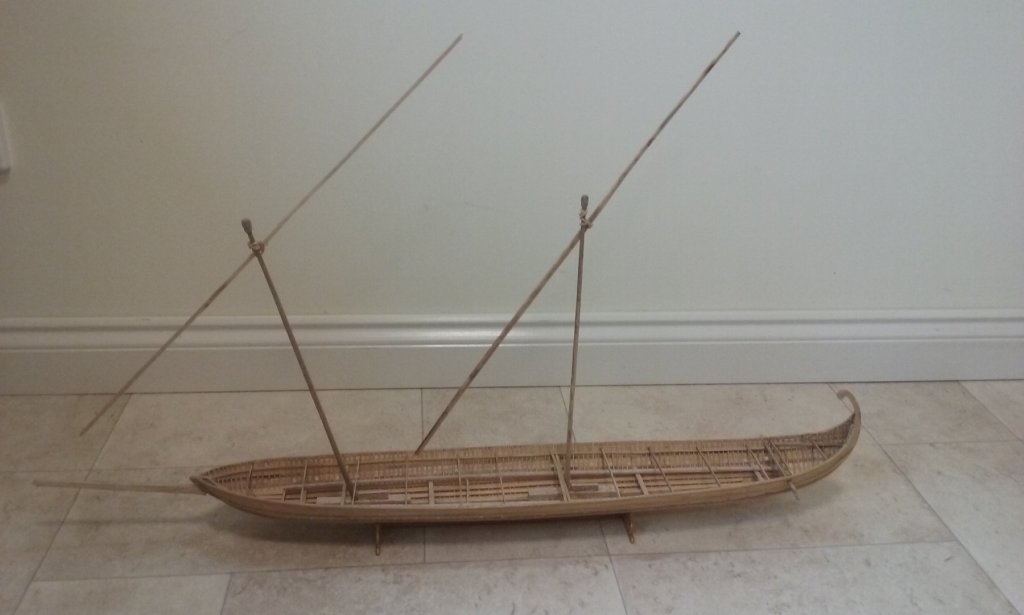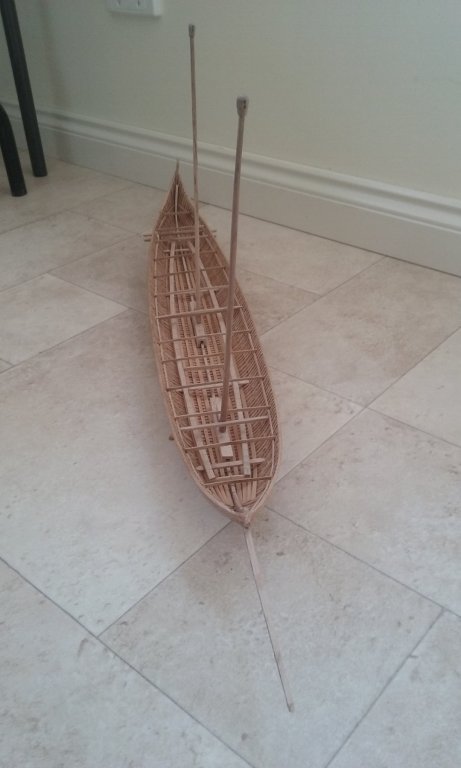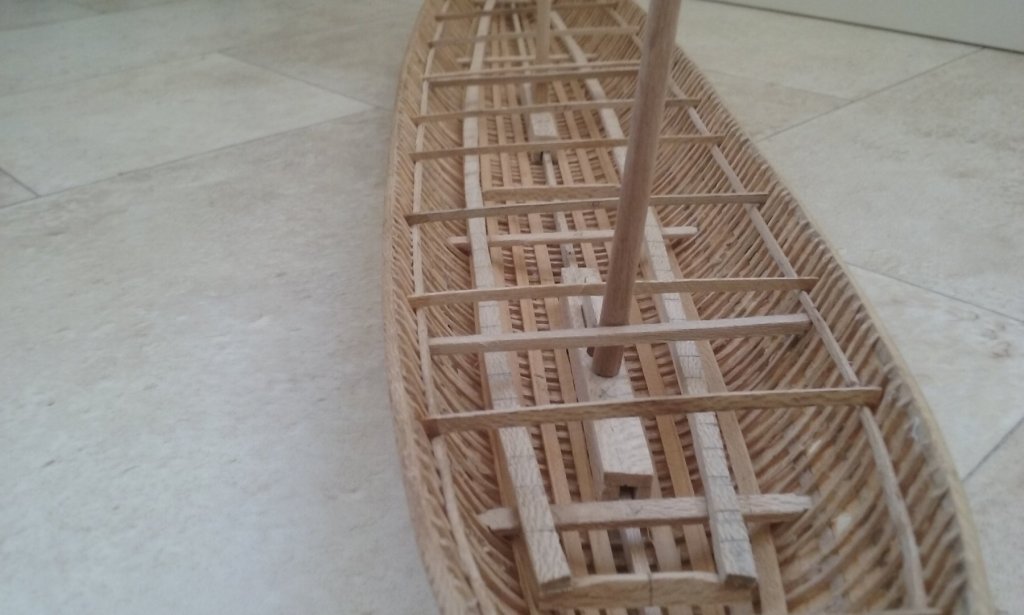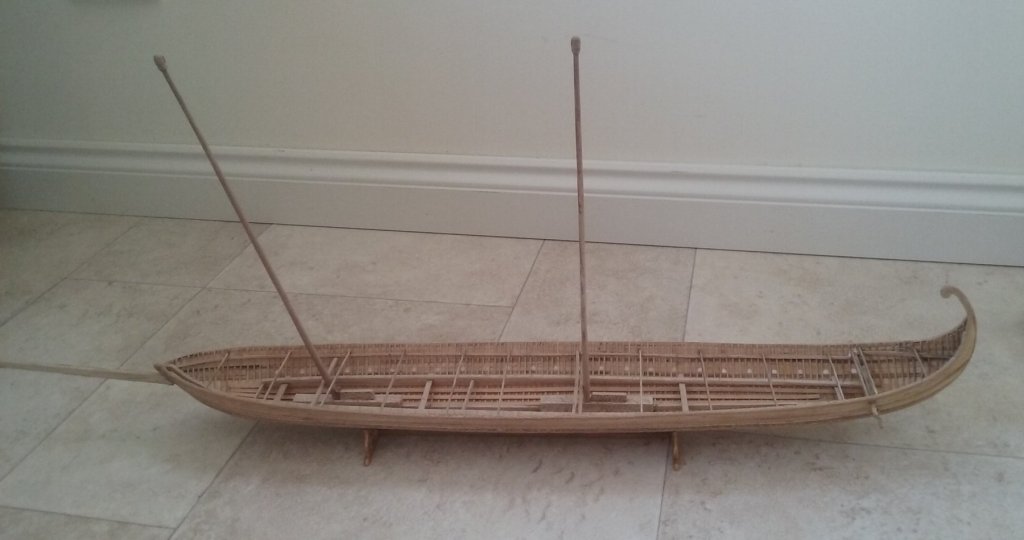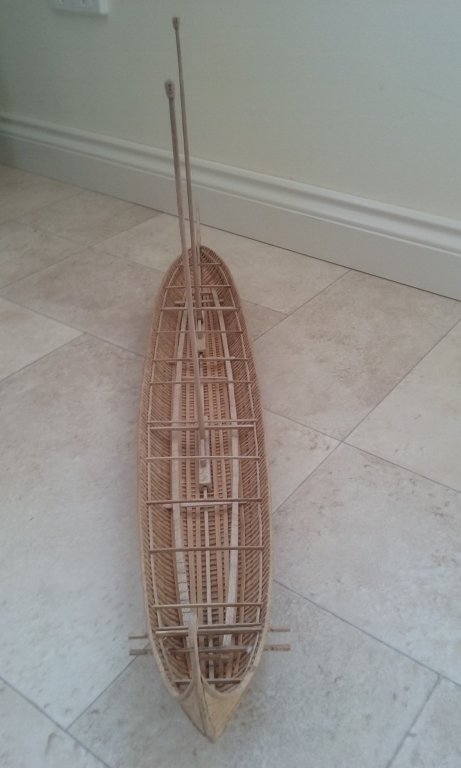-
Posts
7,986 -
Joined
-
Last visited
Content Type
Profiles
Forums
Gallery
Events
Everything posted by Louie da fly
-
Progress on the deck beams. Earlier in the thread, the effect of the spur's weight on the ship's trim was discussed, and I decided that storing the water barrels aft should offset the weight of the spur. So I've put a hatch about 1.5x1.2 metres (5'x4') aft of the middle mast to allow for the water barrels to be lowered into the hull. It's in the second photo but doesn't show up well because I took the photo with too little light. I discovered the beam shelves for the prymne (poop deck) were a bit out of alignment with those for the main deck, which caused the prymne's deck beams to be angled upwards towards the port side. Not very much, really, and my inner demon told me "go on, leave it - nobody will notice". But I'll notice, and if I didn't fix it, it would sneer at me for the rest of time. So one by one I'm taking off the beams and shaving the bottoms at the port end, so effectively the beam will be returned to the horizontal. I've done three so far. You can see the difference in the photo below. A lot of fiddly work, but worth it in the long run. Oh, and I had a very fortunate find. I wanted some chain to support the spur, and had decided to visit all the local op shops (charity stores) to see if there were any cheap jewellery chains I could get hold of. But before I did, my wife and I visited our local branch of Ishka, a shop that sells stuff with a hippie emphasis, Indonesian furniture, that kind of stuff. Found a multiple-chained necklace for $12.50, reduced to 50% on sale, exactly right for the dromon. But that wasn't the best thing. A necklace with really fine chains, in black metal (what, like iron?), already reduced from $24.50 to $5.00, further reduced by 50% to $2.50! I checked to see if this really was the price and being told it was, went and got the only other one in the shop as well. Ideal for the grapnel chain for my sadly neglected Great Harry model which is on the list for eventual restoration and repair. Score! Here's the chain with the spur. I now have enough chain to outfit a fleet! Anyone in Oz wanting some really cool chain might be well advised to check Ishka out. Steven
-
I have some questions regarding chain pumps. Apparently these are the most appropriate pumps for my Byzantine dromon (as remnants were found on the contemporary Byzantine Serce Limani wreck). As I'd never heard of chain pumps before this week, I've done a search through previous posts and they've cleared up the worst of my iggerance, but I still have a few questions. * In the models I've seen, chain pumps always seem to come in pairs - a port and a starboard one. Was this always the case? There were never any single chain pumps? * In all the pictures and models I've seen the pumps seem to be cut off at the outlet (the dale?). Am I right in thinking this leads to scuppers via a pipe or hose? * The dromon only has one deck; the upper deck (if you ignore a little poop deck). So would the pumps and dales be on this upper deck? * In an earlier thread which dealt with chain pumps Druxey replied I realise this is a very different kind of ship from a completely different time and culture and I do have the Serce Limani ship still to check, but lacking surviving evidence to the contrary, would I be safe enough putting the chain pumps "a few feet aft of the main mast"? Any help with these questions would be gratefully received. Steven
- 12 replies
-
- chain pumps
- dromons
-
(and 2 more)
Tagged with:
-
Thanks everyone for the likes. Druxey and Pat, thanks for the comments. Mark, thanks very much for the link. I can't believe I hadn't bookmarked it for myself. I've found it very valuable in chasing up details for this and future proposed builds - including such things as pumps, lighting, lateen rig, seats of ease . . . Just in the last couple of days I've been researching pumps and discovered that though the Romans had chain pumps, they seem to have fallen out of use, at least in Western Europe, until the mid 15th century, when they were rediscovered by a Venetian who ascribed them to the "Tartars" (possibly the Turks? The Tartars weren't a seagoing race). However, the early 11th century Byzantine wreck found at Serce Limani had the remains of what's thought to be a housing for a chain pump, so I'm going to have one on my own model. All I have to do is get more information on what it would have looked like and where it would have been on the ship. The only pictures on the Net appear to be Captain Bentinck's "improved" version, and all the diagrams are a bit lacking in 3Dness. Steven
-
Thanks everyone for the likes. Mark Pearse said: Mark, your comment inspired me to check the headroom belowdecks (something I hadn't thought about before) with one of my carved figures from earlier in the build. It turns out person approx 5'6" tall has the top of his head exactly level with the deck. So though the lower oarsmen might have to duck their heads to move around belowdecks (depending on how tall they were - someone 5'2" may have no trouble at all), it would possibly be no more difficult than in the ships of Nelson's time. More progress on the deck beams. Got as far as the foremast, and created an opening for the mast with intermediate beams at right angles; the deck beam that would otherwise go right across the ship at this point is cut and connects to these beams. I wasn't happy with the finish of the plating on the spur, so I've removed it on the starboard side. The main problem was the glue - I used a clear glue from a junk shop that professed to glue anything to anything. But it was lumpy when applied and made the plating have lumps and bumps. Also I cut the side plating too narrow, so there was a gap at the corner where it joined the plating on the bottom of the spur. This time I made the plating a tiny bit too wide so there was an overlap. Also I tried standard PVA white glue and was rather surprised to find it worked very well - I thought it only worked on wood. A very thin layer of glue, and when I clamped it all together, a very nice flat surface on the plating. Then I bent the surplus aluminium plate around the corner at top and bottom. This covered the join at the bottom, and at the top I filed off the overlapping plating with a fine file so it reached just to the top of the spur. When I do the top I'll bend the plating over both corners to cover the joins, which I think is probably how they did it back in the day. Some of the photos don't have a lot of detail because I took them in the evening when there was too little light. But I find it hard to work on this stuff in the daylight because the reflections are so bright I can't see the detail of what I'm working on. The joins between the plates were scored with an awl and the marks for the "nails" were made with the pointy end of a rat-tail file. They're less obvious this time - the ones I'd done before were too deep to be in scale. Here's the finished product for the starboard side; the port plating is still in progress. I think it looks considerably better than the previous version. Next I have to do the port side and the top, and then colour the plating to look like aged/oxidised bronze. Then I'll make the "iron" - the pointy bit at the business end. And in between times (in daylight) I'm continuing with the deck beams. Steven
-
Dick, that's very interesting about the Contarina ship. The through-beams idea came from a doctoral thesis from TAMU which I was able to download, on the development of the rudder. Unfortunately I didn't bookmark the site that offered all these TAMU theses and now I can't find it again. It may be that they've taken it down, which would be a shame. I did get to download all the ones I was interested in, however, so not all is lost. I've noticed that a reasonable number of mediaeval pictures show either one or the other of these sets of tackle, but I've only come across one source that shows both - a bas relief from the tomb of St Peter Martyr in the church of St Eustorgio in Milan, dated 1339 (see https://www.gettyimages.com.au/detail/photo/ship-in-storm-detail-from-tomb-of-saint-high-res-stock-photography/159618074 ). I'll probably be following this for my own rudders. Pat, it's good to have worked out these issues, but I have a feeling there'll be others just as difficult waiting down the track. Still, the detective work is perhaps the most interesting part of doing a conjectural reconstruction. Steven
-
Here are the deck beams complete for the prymne (poop) in its new configuration. I've laid a couple of planks on the beams so you can see the (rather small) step between the prymne and the main deck. And as I got onto a roll, I started on the beams for the bow as well. When I get further into the main deck I need to make allowance for the deck furniture - at least one (or possibly two) hatches for a ladder below decks, maybe a cargo hatch, plus openings for the masts and also the stands to support the masts and the yards when they've been lowered. But that's yet to come . . . Steven
-
Thanks for the likes. The reason for the problem is that in the original design the prymne was too short - it was both too short and too narrow to hold both the awning and the steersmen - see post 268 of 16 September 2017. By making it longer it also became wider, providing all the room needed. But to avoid the deck sticking out past the gunwale, it had to be lowered. The changes have resulted in about an 8" (200mm) step between the decks. Still not as much as I'd have liked, but enough to look somewhat respectable. It does mean that the steersman's feet are level with the gunwale, but as the rail of the pavesade (the structure to hold the shields at the sides of the ship) extends right back to meet the tail, he shouldn't be in danger of toppling off the side. Steven
-
I put all the beams in for the prymne (poop deck) and dry-fitted planks on the prymne and the main deck. At that point I realised there was only about 4" difference in height - really not a proper poop deck. This problem goes back to the original design for the ship with its curved "tail" - the prymne was originally going to be quite a bit shorter, and extending it makes the line of the deck intersect the gunwale lower down - and there's not much I can do about it. If the poop is much higher it'll be above the gunwale, but I can at least raise it as much as possible. This of course involved removing all the deck beams for the poop, plus the beam shelf on which they rested. So I've done that, and put in a new beam shelf and the highest (sternmost) and lowest (furthest forward) beams, and now I've got to fill in the beams between them. Fortunately I can salvage the beams I took out. They may need to be adjusted in length, but I think I can re-use most of them. If not, they can go in the bow. Steven
-
Beautiful work, Savo. What tools do you use for your woodcarving? Steven
- 27 replies
-
- carrvring
- micro wood carvring
-
(and 3 more)
Tagged with:
-
Thanks, Mark. That helps a lot. Any idea of the likely width of the opening? Obviously enough for a person's shoulders to fit through, but how much wider than that would it have to be (a standard house door is 820mm, and I was thinking of something about that width)? Steven
-

Armed Lugger by altalena18
Louie da fly replied to altalena18's topic in - Build logs for subjects built 1801 - 1850
Looking good, Eitan. Interesting (but totally useless) fact: The vessels that used to be used for pearling in Broome (top left hand corner of Australia) were referred to as luggers, but were always gaff-rigged. I've no idea why . . . Steven -
In the meantime, I've been working on the structure to support and protect the side rudders. A pair of through-beams form the supports, and are cut out to take the rudder shafts. A framework from the beams forward to the hull forms a triangle which protects the rudders from collisions etc. It will be filled in with planking. The upper through-beam is forrard of the lower one, so the rudders will be angled forward to where the steersman stands. The rudder shafts will be lashed to the through-beams, but with enough play so the rudders can pivot around the shaft to steer the ship. I had this structure in place earlier in the build but had to remove it because other things needed to be done first. Now it's time to put it back again. [edit] Looking at the photos, maybe I have to have another look at those oarports. They do look a little rough. [/edit] Steven
-
Thanks for the likes. Also thanks to Don and Carl. That kadirga footage in particular is amazing and very informative. Unfortunately both these vessels are single-banked, so there's no upper and lower deck, so no ladders down belowdecks. I think there are no perfect parallels, because after the 12th century galleys became single-banked owing to a technological advance - first they began having more than one oar per bench (alla sensile), then later a single oar per bench with several oarsmen per oar (a scaloccio). Double-banked galleys vanished from the scene because these new galleys were faster - a higher power to weight ratio - less weight per oarsman because they didn't have that extra deck. I also looked at the footage of the trireme reconstruction Olympias, but they had an upper deck with a "slot" in it running from bow to stern, which gave access to the oarbanks below. So, can anybody who's been building multi-decked vessels, no matter the period, give me some idea of the expected size of the hatch in the deck and the width of the ladder itself? The main factor I have to allow for is getting oars down from deck level through the hatch without obstruction, so the hatch might have to be longer fore and aft than if it were just to allow access for a crewman. [edit] And maybe I should be thinking about adding a cargo hatch as well . . .[/edit] Thanks, Steven
-
This is a lot earlier than I'd thought. I googled "liburnian" and found this, which includes a photo of the 6th/5th century BC Novilara tablet, bearing a likeness of the original from which the Maris Stella model must have come. Even more interesting than I'd originally supposed. Maris Stella come up with some fascinating and original model kits. A really enjoyable build to follow. Steven
- 23 replies
-
- liburnian novilara
- marisstella
-
(and 1 more)
Tagged with:
-
I've been twice already and didn't get to see the kadirga either time (sigh). But at that time I wouldn't have appreciated it anyway - I was interested in other things. And I don't think they'd let me climb up onto her. Steven
-
Again, too little available information, Carl. I can't think of any ship of that period and type in the archaeological record where the deck is preserved with the opening for the companionway intact. But as I mentioned, I think any sailing ship, even from the 18th century, is likely to have had pretty much the same arrangement and would work as a model for mine. Perhaps a chebec would be appropriate? Or perhaps a renaissance galley - but there's only one genuine one in existence as far as I'm aware, the Sultan's kadirga in Istanbul. Steven
-
Doing a test fitting - mainly to work out how long the yards are in relation to the hull to see where to put the supports for the yards when they aren't in use, but also to get an idea of how she'll look when they're rigged.These are just bits of wood - I've yet to make the yards themselves. It's a little known fact that the yards of Byzantine ships were fixed to the masts with large rubber bands 😁. On a more serious note, I will shortly need to locate the companionway which leads below decks, and I really have no idea how big to make it. Can anyone advise me of the usual size of the opening in the deck for a companionway, and the size and angle of the ladder leading belowdecks? I realise there are no available comparisons of similar ships, but I should think the size of opening and angle of the ladder wouldn't change that much over the centuries. Steven
-
A liburnian! Wonderful! Nice to see someone making one of these. I find ancient and mediaeval (oh, and renaissance!) ships more interesting than any others. Watching this with great interest. Steven
- 23 replies
-
- liburnian novilara
- marisstella
-
(and 1 more)
Tagged with:
-
Beautiful job, Greg. I have to say I prefer the grainy photo (though I agree B&W would be better than sepia) - it looks like a photo taken at the time. Modern photos are just too crisp and clean to get the historical "feel" across as well. A real achievement. Steven
- 405 replies
-
- tamiya
- king george v
-
(and 2 more)
Tagged with:
-
A brilliant build of a gallant vessel. My hat's off to you, Carl. Steven
- 292 replies
-
- g class destroyer
- trumpeter
-
(and 4 more)
Tagged with:
-
Mark and Carl, thanks for the kind comments. The space allowance was based on crewmen about 1.67 metres tall (= 5'6" in the old money). This may or may not be a little taller than they were in the day, but I think it should be close enough and allows for someone a little taller than the average of the time. On the other hand the Varangian bodyguard is 1.80 metres (about 5'11") tall - as the Arab traveller and chronicler Ibn Fadlan wrote: "Tall as date palms". For Vikings and Anglo-Saxons of the same period the average height was 1.72 metres (5'8") though according to archaeology it's "not uncommon" for them to have been over 6 feet tall. I allowed for the top of the lower oarbenches to be 450mm (18") above the top of the keel, and the head of the"standard" oarsman to be about 830mm (2'9") above the seat. This then allows for 32mm (1.25 inches) headroom when the oarsman is sitting bolt upright. Not very much, but hopefully enough. Steven
-
Here's the dromon with masts and spur dry-fitted and deck-beams glued in to form the line of the deck, at intervals of about 4-5 beams apart. When they're all in place, there will be a deck beam for every two frames - so there'll be something like 52 of them, and in full scale they'll be 0.48 metre (approx 18") apart, or (where the oars are) two per oarbench. This ties in with the known intervals of 13th century Sicilian galley deck beams. In the close-up picture you can see the very slight upward curve of the deck beams. As I mentioned above they'll be approx 100mm deep in full scale. I'd have liked to make them deeper, but there are serious issues with headroom for the lower oarsmen vs the overall height of the vessel above the waterline and even more importantly the height of the upper bank of oarports above water level. The higher the oarports the steeper the angle of the oars and the harder it is for the upper oarsmen to row. As it is, the lower oarsmen will have just enough room not to bump their heads as they row. Though for this depth of deck-beam there should be fore-and-aft support beams held up by columns at intervals, I won't be putting them in - just too much complication for something that will never be seen. I've also put in the cross-beams for the rudder structure now, to keep from possible interference later on when it's too late to fix. She's starting to look like a real ship! Steven
-
That's what I thought, and that's what I've done. But I think I started out a bit wrongheadedly, and I've since rationalised my way of doing things to produce the same result more simply and with less effort. Steven
About us
Modelshipworld - Advancing Ship Modeling through Research
SSL Secured
Your security is important for us so this Website is SSL-Secured
NRG Mailing Address
Nautical Research Guild
237 South Lincoln Street
Westmont IL, 60559-1917
Model Ship World ® and the MSW logo are Registered Trademarks, and belong to the Nautical Research Guild (United States Patent and Trademark Office: No. 6,929,264 & No. 6,929,274, registered Dec. 20, 2022)
Helpful Links
About the NRG
If you enjoy building ship models that are historically accurate as well as beautiful, then The Nautical Research Guild (NRG) is just right for you.
The Guild is a non-profit educational organization whose mission is to “Advance Ship Modeling Through Research”. We provide support to our members in their efforts to raise the quality of their model ships.
The Nautical Research Guild has published our world-renowned quarterly magazine, The Nautical Research Journal, since 1955. The pages of the Journal are full of articles by accomplished ship modelers who show you how they create those exquisite details on their models, and by maritime historians who show you the correct details to build. The Journal is available in both print and digital editions. Go to the NRG web site (www.thenrg.org) to download a complimentary digital copy of the Journal. The NRG also publishes plan sets, books and compilations of back issues of the Journal and the former Ships in Scale and Model Ship Builder magazines.


